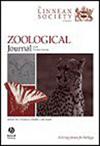Phylogenetic systematics of the genus Cyerce (Mollusca: Heterobranchia: Sacoglossa: Caliphyllidae) from the Pacific and Indian oceans with descriptions of nine new species
IF 2.8
2区 生物学
Q1 ZOOLOGY
引用次数: 0
Abstract
The genus Cyerce Bergh, 1870 has been a model for the study of defensive strategies, including chemical defences, ceratal autotomy, and crypsis or aposematism. Specialization on different algae and diverse genital armatures also make Cyerce a useful system for investigating speciation by host shift versus sexual selection. Here, we review the genus Cyerce in the Pacific and Indian oceans using molecular and morphological data. Two mitochondrial genes (COI and 16S) and one nuclear gene (H3) were sequenced from 154 specimens, including representatives from the Atlantic Ocean. Bayesian and maximum likelihood analyses were used to generate phylogenetic hypotheses. Species delimitation analyses performed on COI sequences recovered 17 genetically distinct Pacific and Indian Ocean species of Cyerce, 10 of which are new to science. Nine new species are named herein (C. takanoi sp. nov., C. katiae sp. nov., C. trowbridgeae sp. nov., C. blackburnae sp. nov., C. tutela sp. nov., C. basi sp. nov., C. whaapi sp. nov., C. goodheartae sp. nov., and C. liliuokalaniae sp. nov.). The 10th species, from the Red Sea, is not named due to the absence of internal anatomical data. These findings increase the species richness in Cyerce by about two-thirds, and demonstrate that even conspicuous taxa harbour considerable cryptic diversity.来自太平洋和印度洋的软软体动物(软体动物纲:异鳃目:舌舌目:软软体动物科)的系统发育系统学及9个新种的描述
Cyerce Bergh属,1870年,一直是防御策略研究的典范,包括化学防御,ceratal autotomy,和隐密或警告。对不同藻类和不同生殖器官的专业化也使Cyerce成为研究宿主转移与性选择的物种形成的有用系统。本文从分子和形态学的角度综述了太平洋和印度洋的Cyerce属。对154个样本(包括来自大西洋的代表)的两个线粒体基因(COI和16S)和一个核基因(H3)进行了测序。使用贝叶斯和最大似然分析来产生系统发育假设。对COI序列进行的物种划分分析发现了17种遗传上不同的Cyerce在太平洋和印度洋,其中10种是科学上的新物种。本文命名了9个新种(C. takanoi sp. nov.、C. katiae sp. nov.、C. trowbridgeae sp. nov.、C. blackburnae sp. nov.、C. tutela sp. nov.、C. basi sp. nov.、C. whaapi sp.、C. goodheart sp. nov.、C. liliukalaniae sp. nov.)。第10种来自红海,由于缺乏内部解剖数据而未命名。这些发现使Cyerce的物种丰富度增加了约三分之二,并表明即使是明显的分类群也具有相当大的隐多样性。
本文章由计算机程序翻译,如有差异,请以英文原文为准。
求助全文
约1分钟内获得全文
求助全文
来源期刊
CiteScore
6.50
自引率
10.70%
发文量
116
审稿时长
6-12 weeks
期刊介绍:
The Zoological Journal of the Linnean Society publishes papers on systematic and evolutionary zoology and comparative, functional and other studies where relevant to these areas. Studies of extinct as well as living animals are included. Reviews are also published; these may be invited by the Editorial Board, but uninvited reviews may also be considered. The Zoological Journal also has a wide circulation amongst zoologists and although narrowly specialized papers are not excluded, potential authors should bear that readership in mind.

 求助内容:
求助内容: 应助结果提醒方式:
应助结果提醒方式:


